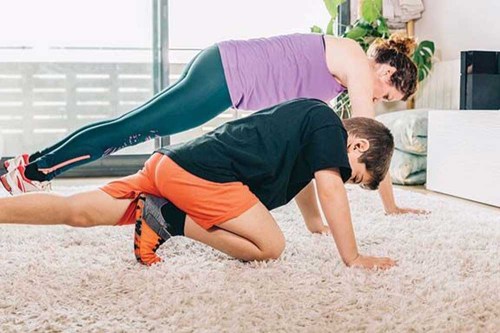Staying fit while staying home
Published 2:21 pm Monday, March 1, 2021

- 1221842903
Keep an exercise schedule and don’t forget to be a role model for your kids.
I don’t think I’m the only one who ended up packing on the pounds in 2020. Being at home all the time with virtually nothing to do tends to have that effect a person. While I am slowly but surely working to get back in shape, I’m starting to see the effects of a stationary life on my children.
Trending
Many parents rely on school and sports to provide opportunities for their children to get regular exercise. My kids used to walk or ride their bikes to school, play at recess, and go to gym class. Secondary students had PE and sports, neither of which has been available in our area in almost a year.
What’s a parent to do? I started by being a role model myself. I can’t ask my kids to do something that I’m not willing to do myself. (I mean, I can, it just isn’t very effective.) So, I started working out for about 30 minutes, three to four times a week. I use the FitOn app. It’s free and it’s perfect for me.
Now that the kids have seen my commitment, I can start hammering home to them that it’s their turn. My boys have distance learning PE and they’re pretty good about doing what they’re asked during that time. However, it’s really not enough for them. I’ve discovered that they are much better about sticking with a plan if they get to create it. So, I suggest stuff, they tell me it’s stupid, and then they have to come up with something they’re willing to do. That’s pretty much how it goes.
The biggest hurdle is just getting them outside. Go for a run, take the dog for a walk, play on the swings, climb a tree, or go all out American Ninja Warrior by creating their own obstacle course and competing against each other. Let’s be honest — changing the “do school in my pajamas, lounge around the house, and snack all day” mentality is not easy. Fresh air and regular exercise is key. Being willing to do it together as a family is an added incentive.
For younger kids, you might consider a jar with popsicle sticks. Each popsicle stick has an activity on it like, ride your bike for 30 minutes, run three laps around the backyard, or count to 100 jumping rope. Then, the rule can be that they need to complete a certain number of tasks before they are allowed to watch TV or play a video game (for a limited amount of time).
Middle school kids need some extrinsic or outside motivation. Consider making them earn their tablet or video game time. Half an hour of active play equals 30 minutes of TV. Maybe some activities are worth more and some are worth less. Bonus: they learn how to negotiate and feel some sort of control over their lives.
Trending
With teens, a light touch is better than a heavy hand. Focus on the intrinsic motivation that being physically active makes a person feel better, happier, and more focused. Allow your teen to do decide whether they would rather be with friends (basketball), or go it alone (running with music). Start small, with some daily expectations like walking the dog or going for a 20-minute bike ride. Ask older kids to take younger siblings to the park. They might even end up playing, too.
As time goes on, slowly build the time up to about an hour or two each day of active behavior. It can be broken up into two or three periods, if needed. The best-case scenario in all of this is the creation of a habit of exercise that has the capacity to support a healthy quality of life for your happy (emphasis on happy) family.
———
Suzanne Kennedy is a former middle school teacher who lives in Pendleton with her husband and four children.









